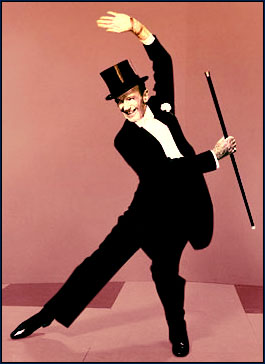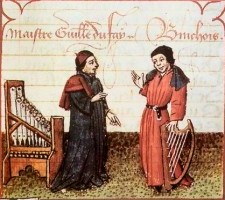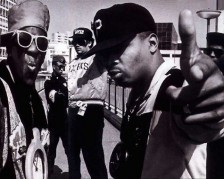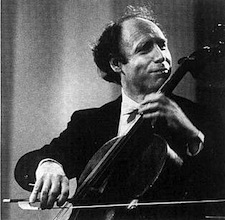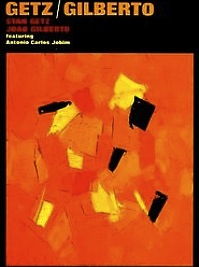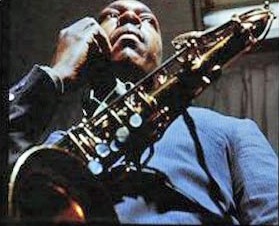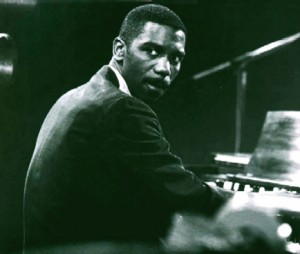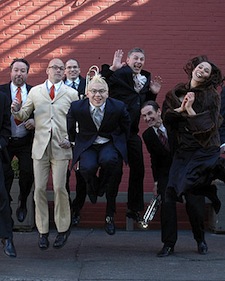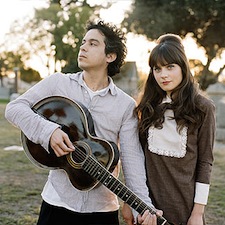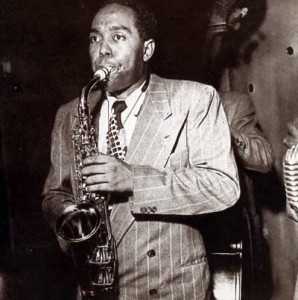How many performers are as classy as Fred Astaire? And while his name rightfully conjures up images of dancing with Ginger Rogers or mirror images of himself, the tracks he recorded with Verve in the 50s. The recordings are a different kind of classy though… not the top hat and white tails kind, but the calm, confident and stylized kind of classy. The way he sings is relaxed, and it sounds like he is having lots of fun. He isn’t the greatest singer, or the greatest interpreter, but when you listen to him sing on these discs it is like having Fred Astaire and Oscar Peterson hanging out in your living room.
Archive for the ‘Jazz’ Category
Day 94. Fred Astaire.
Friday, May 21st, 2010Day 93. Haydn and Duke Ellington.
Thursday, May 20th, 2010I’m continuing work on the stack of Haydn string quartets tonight (only got through a few last night) as well as a few Duke Ellington discs. The Haydn discs, by the way, are from the Naxos set recorded by the Kodaly Quartet. As with most things Haydn, I tend not to think about listening to something by him until I do, and once I do I am almost always struck by how good his music is. And I wonder why he doesn’t get the same amount of attention as Mozart or Beethoven. While he is often given credit as the inventor (or standardizer) of classical form and style, the virtuosic lyricism of Mozart and the dramatic pre-romanticism of Beethoven is the music that is used to complete the music history story of the classical period. Part of it, I am sure, is because it wraps up into a neater package that way. Haydn had these ideas, and Mozart, Beethoven (and Schubert, etc. etc.) expanded them, then etc. etc… But I imagine another big part is the sheer volume of work. I can literally spend two days listening to all of his symphonies without repeating a single one. The five hours it takes to listen to all the Beethoven symphonies lends itself much more to repeated listening of the whole body of work. So of course I know it much better. But with Haydn, even if I chose the top 20 and got to know them as well as I know the Beethoven 9, I would still have 4/5 of his symphonies to be surprised by! So, for now I think I will let myself enjoy the surprises when I get to them. And I will also let myself remember that if I am looking for some good music that I haven’t heard yet, I can dig into my Haydn collection and probably be pleased.
The Duke Ellington tonight is a nice cross-section of his work. There is a collection drawn from a PBS documentary about him that covers a VERY wide range of his work. Basically, it is like taking a survey course on Duke Ellington. With that disc, you get an excellent sense of who Ellington was as a songwriter / composer. Then there is the mostly amazing ‘Ellington at Newport’ from 1956 which shows Ellington the band leader, and finally ‘Money Jungle’, a trio disc from ’62 with Max Roach and Charles Mingus which shows us Ellington the phenomenal pianist.
‘Money Jungle’ is every bit as amazing as you would expect an album by Ellington, Roach and Mingus to be. The playing, all around, is superb. And in the smaller setting, you hear Ellington’s playing in sparser surroundings. This also means that you hear him filling in more space with his playing, and at times his left hand sounds like McCoy Tyner is sitting in. At times, his playing is HEAVY. And I have heard him voice certain chords like this in other contexts (most notably, in the Ella Fitzgerald ‘Ellington Songbook’ recordings), but in a smaller setting with less players, it sounds like he is giving Mingus a run for his money at times. It sounds like he is giving Max Roach a run for his money… and on top of that, he is giving his right hand a run for its money. The playing is just amazing.
But it is the playing of Paul Gonsalves on the Newport disc that is the standout. After a rough start to the festival, the band sounds a bit warn out at times in the first half or so. But by the time Gonsalves starts his solo during ‘Diminuendo and Crescendo in Blue’ you think something amazing has to start happening sometime soon. And it does. The 27 chorus solo that follows is one of the most amazing 6 minutes or so ever captured live on tape. And not to diminish the amazing playing of Gonsalves, but it is also what is going on around him that adds to the moment. Duke egging him on to keep going early in the solo break. Duke and the rest of the band pushing him even further. Then the crowd gets into it. You can literall feel the excitement rise with this recording, and then it ends. Literally, it sounds like Gonsalves has possibly collapsed and is out of breath. It is one of the least graceful endings to a solo you will ever hear, but it is perfect. Gonsalves has given it everything he has got, and when the tune ends, the roar from the crowd (and the time it takes Duke to calm everyone back down to get the concert moving again) shows how just about everyone there realizes how luck they were to hear what they just heard. I’m lucky to hear it. The history of music is lucky that it was caught on tape. I still get chills when I hear this track.
Day 91. A plethora of music.
Sunday, May 16th, 2010Some pretty random selections tonight… a couple of Dufay discs, Zero 7, Kodaly, a Bobby Darin collection, Carmaig De Forrest’s ‘Death Groove Love Party’, the Rushmore soundtrack, Patsy Cline with the Jordanaires and Public Enemy. I’m glad to know that if anyone does a good search for Patsy Cline and Public Enemy from this day forward, my blog will be found.
These were all stacked together in a ‘to be filed’ stack that, well, has never been filed. Being a good white liberal, I of course have a Public Enemy CD. But how many good white liberals have Public Enemy sitting next to Dufay?
Day 89. Vivaldi, Getz/Gilberto, Pink Martini and Bach.
Saturday, May 15th, 2010Tonight I came across a stack of CDs in my bedroom that I discovered while grabbing some freshly recharged AA batteries for my camera. There is a little magazine holder there that really is just holding a robe I never wear and, much to my surprise, a stack of discs. Included in this stack is the Anner Bylsma disc of Vivaldi Concertos that I had been missing (!) as well as Pink Martini’s second album, the Pierre Fournier Bach Cello Suites and the Getz/Gilberto classic. I happily brought the stack downstairs and immediately ripped the Vivaldi and put it on while the girls ate their dinner, and happily announced to Tamiko that I had found the disc. We played it a lot when I first shacked up with her in her apartment on Arch St. in Berkeley, and I mentioned how hearing the music reminded me of that time. She said that it reminded her of when Celia was being born, and that is when I realized that this was the stack of CDs that we took to the hospital with us for Celia and, three years later, with Mira. Not that we did much listening during Celia actually being born (I really only remember hearing Bach Cello Suites that day, early in the process… after that is mostly a blur until Celia was out and all of us had quiet moments here and there over the next couple of days). We had a couple days in the hospital after both girls were born, and the well-known music playing in the background helped prepare both of them, from day 1, for the house of music they would be moving back into.
When I had the Vivaldi on this morning, Celia did some ballet like dancing. She is just as elegant as the music is, and though she is making up almost everything there is doing, I already see a bit of virtuosity in her mind for body movement. Mira laughs as I sing along with Joao Gilberto, and I love that in their life times, my girls have heard music from five continents and over ten centuries. They have adapted it to their own, and can focus on it at times, and enjoy it in the background. The Arvo Pärt disc we also had at the hospital still puts Mira (who turns two in a week) to sleep every night, and Celia moves between Bach and Dowland.
People often ask me if when I am going to start the girls on music lessons. Often I get a shocked glance back when I say ‘when they ask’. They have their hands on instruments whenever they want to, from violins and upright grand pianos to flutes for the bathtub that you tune with water. There is a two octave kid accordion as well. They both dance, and they are both around music everyday. They sing. I’m not worried about forcing anything musical into my girls’ lives. They are already musical, and I cherish that there is so much joy in their lives because of it.
Day 86. John Coltrane.
Tuesday, May 11th, 2010Tonight I made one of my own picks and chose the ‘Heavyweight Giant’ box set that Rhino put out that collected John Coltrane’s albums on Atlantic. Mostly, I had ‘Ole’ in my head earlier today and was surprised not to have it ready to play yet. What I think is a LOT of the fun of this set is Coltrane’s transition into full-time band leader, and starting to stretch out more and more. Tunes stretch out, and you start to see Coltrane tighten up in the technical realm as well. The playing on ‘Giant Steps’ is phenomenal, tight and clean. But by the time you get to ‘Olé Coltrane’, ‘The Avant-Garde’ and ‘Coltrane’s Sound’ you can start to see where his future taking shape (especially as McCoy Tyner and Elvin Jones start to appear on the scene).
For most of my time through college, this set was the Coltrane I listened to and enjoyed the most. As I finished up college (and started to compose more) the later Coltrane on Impulse! took on more of a focus for me. I started to understand and enjoy the REALLY out there stuff quite a bit, so this set has sat on my shelf for quite some time without me listening to it as much.
And that is really too bad, because now that I have started to listen to this set again, I am remembering how amazing it is. Just amazing jazz, and I really appreciate all the alternative takes that show how different each play through of a tune can be. You also see a very melodic Coltrane on some of these tracks as well. ‘Central Park West’, ‘Naima’, and ‘Cousin Mary’ all stand in great relief to the staggering virtuosic playing on ‘Giant Steps’ and ‘Countdown’.
All the music in this set was recorded between early 1959 to mid 1961. ‘Kind of Blue’ was also recorded during this time. Within 2 years, he was signing with Impulse! and finalizing ‘the Quartet’ that would record ‘A Love Supreme’ in 1964. In other words, it is a serious time of transition for Coltrane (even more staggering to think he would be dead by 1967). It is also some of the most polished recordings that I think he made. By the time he goes to Impulse!, he also returns to Rudy Van Gelder to do some of the recording (which I don’t mean to imply is ‘unpolished’, but that the engineering is as much a part of the recording as the playing is… in a good way!). These albums seem to exist out of the rest of his works in a strange way, as though the Atlantic recordings were a chance for Coltrane to get a start away from the collaborative surroundings he had been in to start and discover who he would be as a band leader. And these recordings show some amazing steps being taken. None of the work is poor… these albums are great. These discs are the glue between Coltrane as up and coming sideman and the late Coltrane (and I mean ‘late’ as in ‘late’ Beethoven… where so much exploration and forward looking greatness is found by the artist), and to see the change happen over the course of two years is quite stunning.
Day 69. Miles Davis and John Coltrane.
Tuesday, April 6th, 2010‘Kind of Blue’ was the second jazz album I bought, and it is still one of my favorites. And both of the stints that John Coltrane had with Miles Davis produced some stunning work. The two contrasted each other in some very nice ways – the lyricism of Miles’ trumpet against the much more rapid and harmonic playing of Coltrane. The ‘Complete Columbia Recordings from 1955 to 1961’ captures this second time the two men played together (and also sees Cannonball Adderley, Red Garland, Bill Evans, Wynton Kelley and others during this time span). It leaves the cool jazz of the Prestige years behind and forges ahead with hard-bop, then into the modal experiments of ‘Kind of Blue’, wrapping up with a beautiful recording of ‘Someday My Prince WIll Come’. There are also a few live recordings on the box set, and the energy of Coltrane live (and his endurance) certainly drove Miles Davis creatively, though it also drove him mad. In a book of jazz anecdotes that I have, someone asked Coltrane (with Miles sitting next to him) how his solos get to be so long, and Coltrane stets to the point of saying that he just doesn’t know how to stop them. Miles leans forewarned and sees ‘you take the fucking horn out of your mouth!’. Strangely enough, after hearing this quote I began to hear that this is exactly what Miles Davis would do at times.
I can’t possibly write about how brilliant these recordings are. And there is something very special about the relationship you hear between Davis and Coltrane, undeniably two of the greatest jazz artists of the 20th century. The partnership basically ends with Miles Davis kicking Coltrane out of the band a second time, reportedly for drug use. Some stories I’ve heard had Miles doing this in hopes of getting Coltrane to kick his habits. And others talk about the deep regret Miles Davis had after Coltrane’s departure. While I can’t find the actual quote, one that was told to me by a friend sticks in my mind. While hearing Roland Kirk play 4 horns at the same time and make beautiful contrapuntal melodies, someone supposedly leans over to Miles and says ‘man – could you imagine having someone that can play like that?’ and Miles replies ‘I did once… I did’.
Day 67. Jimmy Smith.
Sunday, April 4th, 2010I have a live Jimmy Smith disc on right now (‘Cool Blues’) and DAMN it is smoking. Art Blakey is on a few tracks, Tina Brooks and Eddie McFaden on others. And while I fell in love with Jimmy Smith the first time I heard him, hearing this kind of playing really reminds me why. This disc is from 1958, and it is just astounding how tight these guys are playing together. This is two years after he signs with Blue Note (and basically is introduced to the jazz world) and here he is playing with Art Blakey like they are old pals.
For those who don’t know Jimmy Smith’s music, his story is almost mystical. He starts off as a piano player until he hears Wild Bill Davis playing organ in the mid-50s or so. He goes out and buys an organ, rents a warehouse and basically locks himself inside for a year or so, then emerges onto the Philadelphia jazz scene. He is discovered almost immediately by Blue Note, and records over 40 sessions over the next 8 years (with the disc I am currently listening to among them). Many are live, and quite a few are in Rudy Van Gelder’s studio. But there is a consistency in the performances that reveals how hard he works.
The other thing that often surprises first time listeners of Jimmy Smith’s music is that, for the most part, there isn’t a bass player on any of the discs. He plays the bass lines mostly with the pedals of the organ or with the left hand of the keyboard. There is an amazing level of complexity in just HIS playing, that when the others come together with him it can hurt to think about everything that is being held together by just a few human beings. It’s better to just go with the groove, and the groove is what is the strongest element of Jimmy Smith’s music. It has probably one of the strongest shuffles for players from his generation, and it goes well with the toe tapping he has happening to play the pedals.
Tonight I ripped ‘Cool Blues’, ‘Open House’, ‘Prayer Meeting’ with Stanley Turrentine, ‘Home Cookin” and the companion discs ‘House Party’ and ‘The Sermon’ (which both basically come from the same sessions). I think ‘The Sermon’ is probably one of the top 10 jazz albums ever made, and the title track is a 20 minute tour de force that feels more like a jam session at points. Each player takes a pretty long solo, and seems to be outdoing whoever came before them. Most of the other tracks from these sessions are standards or Charlie Parker tunes which seem to be the warm-up parts. All the tracks on these two albums were recorded over two days, and I get the sense that there weren’t many takes of any of these… we’re just hearing what happened while the tape was rolling, and it’s good. These sessions also see Art Blakey and Tina Brooks playing, as well as Lee Morgan and Curtis Fuller. All of these guys were Blue Note staples, and as I think I have mentioned elsewhere, certainly any of them could have been the headliner for their own albums or shows. It’s a shame that musicians (and the labels they are associated with) tend to keep much more to themselves now. Stax Records for instance got along for a couple of decade with a house band that brought in different lead singers for their albums, and Blue Note had a whole building full of jazz musicians that they could pull together to play on each others albums. Just doesn’t seem to work that way anymore.
Day 66. Frank Sinatra.
Saturday, April 3rd, 2010While continuing on with the complete Bach set I ripped a couple of Frank Sinatra collections tonight. I don’t know what it is, but I tend to respect a business more if I occasionally hear Frank Sinatra playing in it. Our favorite grocery store has Ol’ Blue Eyes playing over the speakers every now and then, I always felt like I was cooler at Tower when Frank Sinatra was playing over the speakers, and I will always remember Rod at Wall Berlin singing along with ‘Witchcraft’ at 12:30am. Unlike a lot of the CDs I have done so far though, I can’t really think of a time that these have fallen out of playing rotation… even when the CD player was unplugged, these discs were probably in my computer at least once and listened to. Mira and Celia have both heard Frank Sinatra a good amount, and why not? So beautiful love ballads here and there, so up tempo swinging tunes as well. And I don’t think they can listen close enough to the words of ‘South of the Border’ for me to be concerned yet.
Around the time that Sinatra died, there was a joke I heard once that I modified a bit to make it seem more like a personal family story… it was something like:
“Ah – Frank Sinatra is gone, god-bless his soul… he saved my grandfather’s life once you know! Grandpa had run up a pretty high debt at a casino in Vegas in the 50s once, and the owner had him taken out and beat up since he couldn’t cover the debt… and Frank, god-bless his soul… steps in and says ‘OK boys, he’s had enough!”
If you know about the possibly shady sides to Frank’s past (and if my timing was right) this joke would get a very serious ‘Really?’ from almost everyone I told it to, followed a few seconds later by a pretty good laugh once someone realized they had been had. If you’ve been reading any of the other blog entires you might remember that I mentioned that my grandfather DID once say to me that ‘sure, if you’re Italian you have to like Frank Sinatra, but REAL Italians like Louis Prima more’. While I did hear much more Louis Prima and my grandparents house, Frank Sinatra was on quite a bit there as well (especially after they got their first CD player). So while I do associate Frank Sinatra with cool places to shop / have coffee, mostly I think of Frank Sinatra when I’m cooking since he was often the soundtrack at my grandparents as well. Frank on the speakers, red sauce on the stove… mmm…
Day 57. Pink Martini, She & Him and M. Ward.
Monday, March 22nd, 2010So – tonight I have been plugging away on some new code, trying to learn a bit more abbot programming interfaces for Apple’s Interface Builder (which creates the visual part of an application that we usually see when we launch an application). Fun. Kind of. But – I didn’t get to rip any discs. BUT I did buy a couple new ones. She and Him Volume 2 came out ‘today’ at 9pm (midnight east coast time) and I discovered that Pink Martini also has a new one. Or a newer one… at least one I hadn’t seen before. Not sure what to think about the new Pink Martini so far… one of the songs just ripped of the first Tchaikovsky Piano Concerto. And I don’t mean it quoted it… I mean it used bits of melody with a ‘wrong note’ every six or seven notes. The song before that sounded like ‘Cantaloupe Island’ by Herbie Hancock, but again, not quite. I’m hoping it gets better though. Pink Martini’s first album absolutely stunned me with how great it was. It came out in 1997 after the group had been together for a few years. It was, and still is, amazing. ‘Hang On Little Tomato’ came out 7 years after that, and was a great second album. ‘Hey, Eugene’ came out 3 years after that, and it was a little ‘eh’. The new one took two years. I’m concerned after just a couple tracks. I’ll listen to the rest later and hope it gets better… on to the new She and Him for now (so Tamiko can hear it as well right now as she sites next to me).
I thought the first She and Him was brilliant. It really grew on me, and there were a few weeks this last summer that I had it on just about everyday. So far, number 2 is sounding good as well. So melodic. And M. Ward really can do almost no wrong in my book. My friend Charles sent me a mix disc a couple years ago with ‘Chinese Translation’ on it and that was one of those songs that I immediately tracked down so I could buy the album. This was right after I started to use eMusic – and there he was. I went ahead and purchased a few other albums from him over the next couple weeks and he has been a steady part of my pop musical diet ever since. I eagerly await his (and their) new releases. I would even go so far as to say that if you are serious about pop music in the 00s, you need to have an opinion about M. Ward. (If you are serious about pop music in the 90s, I think you need to have an opinion about Yo La Tengo). These artists I think show that you know more then just what the music industry ‘tells us’ to listen to. If my musical snobbery is a mountain range, it is probably statements like these that are some of the peaks. I know this is not necessarily an attractive side to me, but I would also lie if I didn’t admit to it. Anyways, so far so good on the new She and Him… and that’s it for tonight. I’m beat.
Day 54. Charlie Parker.
Thursday, March 18th, 2010I came across Charlie Parker the first time in high school jazz band my freshman year. We played ‘K.C. Blues’ and I went out and found a compilation that afternoon (“Bird: The Original Recordings of Charlie Parker on Verve”). It was also my introduction to Verve Records and Bop. As I got more and more into jazz, Charlie Parker was one of the artists I explored first. I was playing alto sax at the time and had access to a few transcriptions of solos (which I simply couldn’t play).
During my years at the Tower in Roseville I would pick up discs as they would come in (and eventually order the ones I wanted). And he became on of the artists that Tamiko and I liked to listen to together. One of the best finds came with a box of Japanese imports that were just sent to the store. We didn’t know what was in the boxes – they were just packed together by Tower’s import department and sent to us. In one of these boxes was ‘Charlie Parker with Strings, the Complete Master Takes’. $35 for the disc and I took it to Tamiko the day I got it. This isn’t Bird in Bop mode, but Bird in melodic and romantic mode… great date music. This was the only copy of the disc we got as well (and I didn’t see it again for close to 10 years until it was re-issued in the states)
Tamiko had an old Datsun B-210 that, like most cars from the 70s that survived into the 90s had quirks. The B-210’s quirk was that, when cold started, would stall on a hill. And it just happened that her house in Roseville sat on a road that rose in the middle (creating a kind of hill to the curb). Well – someone broke into the B-210 and tired to steal it. Luckily, the car died. Unluckily a box of CDs that was in the back was taken, and along with it the Charlie Parker with Strings disc. Tamiko felt horrible about it, but I was just glad everything else was ok. About a week later I get to work and sitting in the return bin at Tower is the Charlie Parker discs along with a few others that were taken! The crook had returned them for store credit!!! No one remembered anything about the guy, but I was able to buy the disc back again.
Just now I put the recording on (after ripping it) and in just a couple of notes Tamiko shot me a smile. In the first couple of notes, I was hit with the image of the two of us in her apartment on Arch Street in Berkeley, listening to the disc with the windows open and the cool sea breeze streaming in. Sure – I have a good amount of Charlie Parker to rip tonight (lots of Bop especially – and a great disc with a VERY young Miles Davis playing backup) but I wonder how many of the discs on my shelves will create such a vivid memory for me (or make Tamiko smile so quickly). Probably not many.


